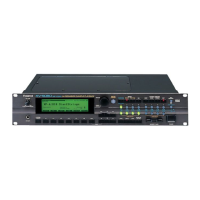39
Chapter 2 Using the XV-5080 Effects
Chap.2
• For Type: 2 (DELAY)
Center (Delay Center) 200–1000 ms, Note
Sets the delay time for the delay located at the center of the
stereo field.
Left (Delay Left) 200–1000 ms, Note
Sets the delay time for the delay located at the left side of the
stereo field.
Right (Delay Right) 200–1000 ms, Note
Sets the delay time for the delay located at the right side of
the stereo field.
HF Damp *1
This allows you to reduce, or “damp,” the high-frequency
content of the repeated feedback delays—frequencies above
the selected value will be damped. If you do not want to cut
the high frequencies of the feedback, set this parameter to
BYPASS.
*1 200, 250, 315, 400, 500, 630, 800, 1000, 1250, 1600, 2000,
2500, 3150, 4000, 5000, 6300, 8000 Hz, BYPASS
Feedback -98– +98%
Adjusts the amount of delay feedback, controlling the
number of times the delay repeats. With negative (-) values,
the phase of the repeated delays is inverted.
Center (Delay Center Level) 0–127
Sets the volume level of the delay located at the center of the
stereo field.
Left (Delay Left Level) 0–127
Sets the volume level of the delay located at the left side of
the stereo field.
Right (Delay Right Level) 0–127
Sets the volume level of the delay located at the right side of
the stereo field.
Making Reverb Settings
These settings allow you to select the desired type of Reverb,
its characteristics, and the pair of OUTPUT jacks to which the
Reverb unit’s stereo output is routed.
On the Effects General page, set the following parameters.
Reverb Type
Selects the type of Reverb.
0 (Off): Reverb is not used.
1 (Revrb): Normal Reverb
2 (Room): This reverb simulates typical room acoustic
reflections.
3 (Hall): This reverb simulates typical concert hall acoustic
reflections.
4 (Plate): This reverb simulates a reverb plate, a popular
type of artificial reverb unit that derives its sound from the
vibration of a metallic plate. You can also achieve unusual
metallic-sounding reverbs using SRV PLATE.
Reverb Level 0–127
Specifies the output level of the Reverb.
Reverb Output Assign A–D
Selects the OUTPUT jacks to which the Reverb unit’s stereo
output is routed.
Pressing [F5 (Reverb)] in the General page calls up the
Reverb page, in which you can make the following settings.

